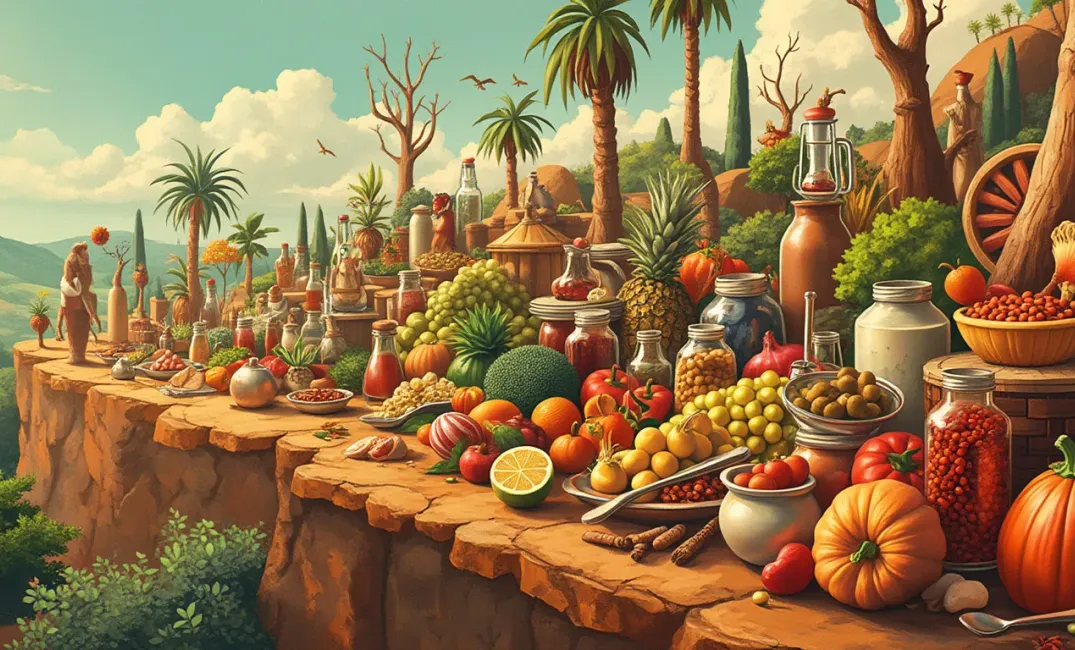The Evolving Art and Science of Food
Food has perpetually served as a cornerstone of human civilization, offering sustenance and pleasure while shaping cultures, economies, and societies. From rudimentary methods of gathering and hunting to the intricate culinary arts and innovative sciences, the story of food is a testament to humanity's ingenuity and adaptability.
The Dawn of Culinary Exploration
Humanity's journey with food begins with the primal art of harnessing nature's bounty, evolving through transformative epochs that redefined societies and civilizations.
- The Hunter-Gatherer Epoch: For tens of thousands of years, humans lived as hunter-gatherers, relying on a keen understanding of their environment. Foraging for edible plants, hunting animals, and developing early culinary techniques laid the groundwork for communal feasts and kinship.
- The Agricultural Revolution: Approximately 10,000 years ago, the advent of agriculture reshaped societal structures, providing reliable food sources and catalyzing the rise of cities. Domestication of crops like wheat and rice enabled population growth and cultural blossoming, leading to sophisticated culinary practices.
- The Spice Road and Trade: The dynamic exchange of spices and exotic ingredients across continents marked a period of culinary enrichment and cultural fusion. Spices became symbols of wealth and power, igniting exploration and imperial ambitions.
Culinary Traditions and the Palette of Culture
Across diverse societies, food transcends mere sustenance, reflecting cultural identities, religious beliefs, and social cohesion. It is both art and ritual, a canvas for tradition and innovation.
- Rituals and Festivals: In many cultures, food is integral to religious and cultural ceremonies, symbolizing prosperity and gratitude. Celebrations like the Indian Diwali, Chinese New Year, and American Thanksgiving are imbued with particular foods that convey communal harmony and shared history.
- Gastronomy and the Art of Cuisine: Gastronomy evolves into a cherished art form through the meticulous balance of flavors, textures, and presentations. Cuisines like French, Japanese, and Italian achieve acclaim for their creativity, precision, and dedication to culinary heritage.
- Fusion and Innovation: As cultures intersect, fusion cuisines emerge, blending traditional techniques and ingredients to create unique flavors. This continual evolution testifies to the adaptability and endless possibilities of culinary exploration.
The Intersection of Science and Culinary Craft
Advancements in scientific understanding and technology bring forth new dimensions to the art of cooking, emphasizing precision, creativity, and sustainability.
- Molecular Gastronomy: Pioneered by culinary innovators like Ferran Adrià and Heston Blumenthal, molecular gastronomy delves into the chemical and physical processes of cooking, unveiling transformative techniques like spherification and emulsification to redefine culinary experiences.
- The Science of Nutrition: Science unlocks deeper comprehension of nutritional intricacies, guiding dietary choices and public health initiatives. The impact of macronutrients, micronutrients, and bioactive compounds on human physiology shapes dietary guidelines and innovations in food production.
- Sustainable Food Systems: Confronted by environmental challenges, science and technology champion sustainable practices, from vertical farming and lab-grown proteins to sustainable fisheries and agroecology. These initiatives seek to harmonize human needs with planetary stewardship.
Food as a Catalyst for Change
Throughout history, food and its production have acted as catalysts for social, political, and economic developments, reflecting humanity's capacity for advocacy and transformation.
- Agrarian Movements and Reforms: The demand for equitable food distribution fuels agrarian movements and reforms worldwide, challenging land ownership structures and advocating for the rights of farmers and laborers.
- Globalization and Ethical Trade: The globalization of food systems transforms supply chains and consumer awareness, pushing for ethical sourcing, fair trade, and environmentally responsible practices that support equitable growth.
- Culinary Diplomacy: Food encompasses "gastrodiplomacy," an approach to fostering cultural exchanges and diplomatic relations through culinary experiences, facilitating cross-cultural understanding and cooperation.
Modern Challenges and the Future of Food
As humanity grapples with contemporary challenges, the future of food hinges on navigating complex sociopolitical landscapes and pioneering technological advancements that ensure resilience and equity.
- Hunger and Food Security: Ensuring global food security remains a critical challenge amidst population growth and climate change. Collaborative efforts between governments, NGOs, and the private sector aim to eradicate hunger and build resilient food systems.
- The Role of Technology: Emerging technologies—such as blockchain for transparent supply chains, AI-driven agricultural machinery, and personalized nutrition platforms—hold promise in enhancing productivity, traceability, and dietary personalization.
- Culinary Education and Inclusivity: Education emerges as a vehicle for culinary inclusivity, celebrating diverse food cultures while empowering underrepresented voices in the culinary sphere through platforms and initiatives.
Conclusion: A Feast for Mind and Spirit
From ancestral connections to future potentials, food represents a shared history and a beacon for innovation. It serves as a reminder of the resilience, creativity, and unity inherent in every meal shared and every dish crafted. Future explorers can draw inspiration from this legacy, crafting their narratives on uncharted horizons.
Midjourney prompt for the cover image: A historical journey through the evolution of food, depicting ancient hunter-gatherers, agriculture, spice trade, and modern molecular gastronomy, in an abstract Pixar Style illustration, capturing cultural and scientific richness.

